Paper and Writing
Hieroglyphics
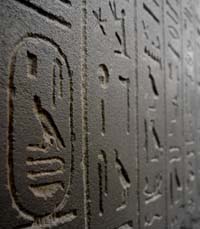
The ancient Egyptians were among the first groups of people to write and keep records of events that happened in their lives. The earliest form of writing was in the form of hieroglyphics, which, simply put, were drawings that portrayed a story. Hieroglyphics are some of the oldest artifacts in the world today, and the Egyptians used them to keep accurate records and maintain control of their empire.
Click here to discover more about Hieroglyphics
Papyrus
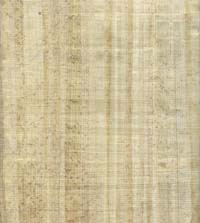
Papyrus was the first form of durable sheets of paper to write on, and the ancient Egyptians were the ones to develop it. The material was termed “papyrus” because it was made from the papyrus plant.
The ancient Egyptians primarily used papyrus for recording religious texts and other important documents. Papyrus was mass producedin Egypt and sold to other ancient civilizations, such as Ancient Greece, for their record keeping.
Click here to discover more about Papyrus
Ink
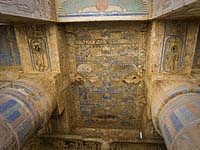
One of the inventions in Egypt was, surprisingly, black ink. The Egyptian people were very talented at creating not only black ink, but many multi-colored types of ink and dye. The process and depth of color utilized in the Egyptian invention of ink and dye was so marvelous that these brilliant hued colors can still be seen today, thousands of years later.
Time Telling
Calendars

The ancient Egyptian calendar was invented more than 5,000 years ago and was originally based on the 12-month lunar cycle. They grouped the months into three seasons of four months that seemed to coincide with the Nile River.
However, this calendar wasn’t accurate enough. They soon noticed that although the river would flood every year around the end of June, the flood occurred within a range of 80 days.
Therefore, after noticing that the river’s flooding and rising coincided with the heliacal rising of the star Sirius, they based their year on the cycle of this star’s reappearance, effectively applying astronomy principles to develop a more accurate calendar by which to track the days of the year. We still use ancient Egyptians’ calendar model in our tracking of the days today.
Clocks
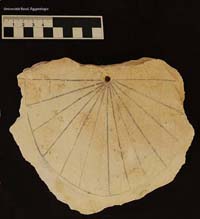
Ancient Egyptians were also one of the first groups of people to divide days into equal parts through the use of timekeeping devices. Some of the earliest forms of clocks were sundials, shadow clocks, merkhets and obelisks.
Generally, the passing of the day was determined by the position of the sun, and the passing of the night was determined by the rise and fall of the stars.
There is even evidence of water clocks in ancient Egypt. These were shaped like bowls and had a small hole in the bottom of them. They floated atop water and were allowed to fill up in a way so that the rising water represented a number of hours passing.
Water clocks were mostly used by priests, as they allowed a way to measure time independently of the sun and were more accurate gauges of time for performing special religious ceremonies.
Construction
The ancient Egyptians are known for their massive constructions and outstanding architecture. Many of their earliest buildings are no longer standing, having been subjected to war, ruin and other elements. The ones that are remain marvels of architecture, such as the Great Pyramid of Giza, which is one of the Seven Wonders of the World.
Pyramids
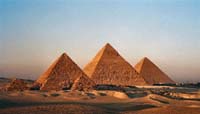
There remains speculation regarding how the ancient pyramids were constructed. However, the first truly triangular shaped pyramids are counted among the many ancient Egyptian inventions, although it took them several tries in order to achieve an ideal model.
Organized Labor

The Egyptians were the first to invent and employ organized laboron a massive scale in order to construct these magnificent stone structures.
When one takes into consideration that the construction of just one pyramid often lasted several decades, the magnitude of the organized labor required becomes enormous.
Simple Machines
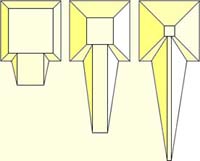
Part of what made it possible for the Egyptians to build some of the great buildings and monuments that they did was the employ of certain simple machines that they invented to assist them in the process. The ramp and the lever were a couple of the most famous construction inventions that the ancient Egyptians developed, and the principles that guide them are still widely used in construction today.
Ships and Navigation
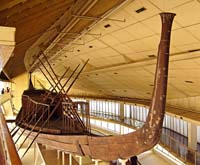
Trade was an important part of ancient cultures, so having working ships was extremely important. The ancient Egyptians employed knowledge of the science of aerodynamics in their ship construction processes to create ships that would catch the wind and push vessels through the water. They developed the use of numerous sails that could be adjusted to sail ships against the wind using side winds.
They also came up with the concept of using rope trusses to strengthen the beams of their ships, and they were also the first ones to stem-mounted rudders on their ships. At first, they built small boats out of papyrus reeds, but eventually they began to build larger ships from cedar wood.
Agriculture
Agriculture was extremely important to ancient civilizations, as it still is today. Without sufficient crops, there isn’t enough food for humans to survive.
Ox-Drawn Plow
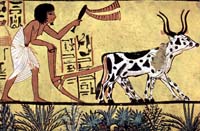
While not thought of in quite the same aspects as the tools we know today, the first ox-draws plows appeared in Egypt as early as 2500 B.C. This advancement in agriculture required skilled metal working in order to form a workable plow, as well as animal husbandry.
One might wonder why the ancient Egyptians would have even needed ox-drawn plows when the majority of the Egyptian nation consists of deserts. While there certainly is a great amount of sweeping desert land in Egypt, the nation is also the home of extremely fertile black soil along the banks of the Nile River. This area provided a very hospitable environment for growing crops such as wheat, in addition to a multitude of vegetables.
Irrigation

Of course, humans cannot control the amount of rainfall that is supplied to the Earth. Therefore, the ancient Egyptians developed irrigation systems using hydraulic engineering principles. Such systems were designed to replace rainfall during periods of drought. Early evidence indicates that irrigation systems were used in ancient Egypt as early as the twelfth dynasty, using the lake Fayum, as the reservoir to store water surpluses.

















































